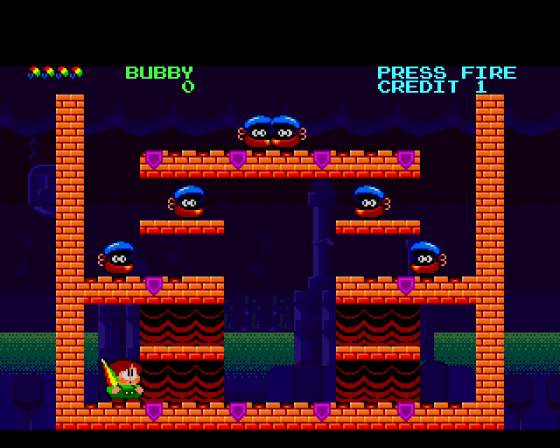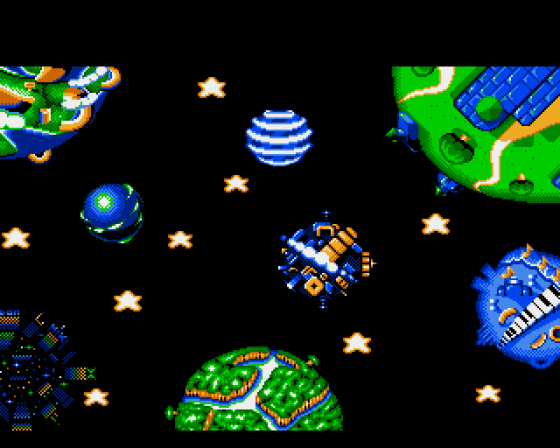
Amiga Power
 1st April 1992
1st April 1992
Categories: Review: Software
Author: Stuart Campbell
Publisher: Taito
Machine: Amiga 500
Published in Amiga Power #12
Parasol Stars
It's here at last! Man the barricades, batten down the hatches, splice the mainbrace, no-one here gets out alive! Time for some (serious) reviewing...
Parasol Stars is the third game in the Bubble Bobble series, having been preceded by Bubble Bobble (obviously) and Rainbow Islands, the current Amiga Power choice as Best Amiga Game Of All Time. And that's all the background you're getting 'coz, quite frankly, all three games have such silly, dodgily-translated Japanese storylines it'd be a total waste of space to go into them here. Instead, let's get right down to the nitty-gritty - is this game better than Rainbow Islands, or what?
No.

There you go, pretty revolutionary concept, huh? Now some of you may be thinking, "He's thrown away his best card dangerously early in the review there, this is a review of 1,200 words and it's going to need 110 percent effort if he's going to keep the crowd interested to the end", but the point to note here is that, despite what everyone in the world (including us) might have said, it doesn't really matter two hoots how this compares to Rainbow Islands.
Well, it does a bit, if only for the sake of argument, but the most important thing by far is - and forgive me if I'm stating the obvious here - how good a game it is in its own right. The best pedigree in the world means nothing if it's just used to seel a mediocre cash-in (ref Gauntlet III), just like the worst background imaginable can still produce an all-time classic (ref The Blues Brothers). So forget about the history. Forget about Rainbow Islands. Forget about Bubble Bobble. Forget the hype. Forget your own name if you like, but let's take a cold, hard look at Parasol Stars: The Game.
Somewhere Over The Rainbow
This map screen which appears between worlds shows you the state of Bubby and Bobby's universe as the game proceeds. Initially all the worlds except Rainbow World (the starting point of Bubby and Bobby's adventure) are filled with dull greys but as the boys complete each stage, the worlds are returned to their natural colours.

There are seven worlds to start off with, but successful completion of secret tasks reveal another two (the colourful knobbly one near the bottom right and the spooky-looking one near the top left on the map) which can be tackled after the last normal world in order to see the 'proper' end sequence. This is the same as the original PC Engine version of the game, but Ocean's programmers have also created another brand-new, exclusive world which can be accessed purely for kicks and bonus points. It's not actually shown on this map, and we're not going to blow the surprise by telling you how to get to it just yet, but it is in there. Stand by then, for Music World, Woodland World, Machine World, Casino World and a few more besides.
Trouble With Bubbles
That's trouble for the baddies, of course.
Scattered throughout the various screens of Parasol Stars, you'll find little bubbles with one of four icons inside. All of them can be grabbed with your parasol and fired at the baddies to identical effect, but collect enough of them and they form one giant bubble, each kind of which behaves in a different way.
-
Water
Form a giant water bubble and release it and it acts like the water flow in Bubble Bobble, sending a stream cascading to the bottom of the screen by the quickest possible route, carrying any baddies (or Bubby or Bobby) who get in the way along with it, or inflicting serious damage on any nasty big enough not to get swept away. -
Fire
A released fired bubble also imitates a Bubble Bobble feature, the napalm droplet. It causes a sheet of flame to spread over the floor for about four times Bubby or Bobby's width, which is deadly to any baddie that touches it (except end-of-level bosses, who suffer severe damage). Bubby and Bobby must take care not to step in the flames themselves, though, or they'll be frozen (if that's the right word) to the spot for several seconds. -
Lightning
Yet another refugee from Bubble Bobble, the giant lightning bubble actually behaves like an overgrown version of the little lightning bubbles. Let loose a big one and it shoots across the screen, obliterating everything in its path and going through walls like they weren't there. (But again, you'll need to hit an end-of-level boss several times even with these.) -
Stars
The only weapon which doesn't have an ancestor in Bubble Bobble. Fire up a giant star bubble and the five little ones making it up will separate again, form a circle and spin off in a massive spiral pattern, inflicting the appropriate havoc on anything they touch. As you don't have to line yourself up with an enemy to use this weapon and it covers more or less the entire screen, this is the most powerful power-up you'll get.
Oh No! It's Hypocrisy Alert!

Okay, so I know I just said 'forget about Bubble Bobble', but the unavoidable first thing that strikes you when you start to play Parasol Stars is just how like its illustrious parent it is. Single screens (for the most part, a few levels scroll horizontally a little bit), masses of baddies in set formations, and often loads of bubbles floating around containing weapons lifted directly from the original game. The nasties' movements are noticeably similar too: floaty, bouncy, jumpy kinds of stuff, and they even share the same property of getting 'angry' if you half-kill them and then allow them to recover before you finish the job off.
Gameplay-wise you've got the same objective, just kill everything on each level and move onto the next one, making judicious use of the Bubble Bobble-type power-ups and bonuses which appear seemingly (but almost certainly not, as any Rainbow Islands devotee will tell you) at random around the screen. Perhaps a good comparison to make at this point would be with Switchblade and Switchblade II - in that case too, a simple arcade game was followed by a sequel which upped the style quotient by several hundred percent and refined the design almost to perfection without really changing it a significant amount. (And, the original Switchblade was over-rated too, but let's not get into that...)
Step Back In Time, Dr. Wells
In many ways then, Parasol Stars is a step backwards (at least in design terms). But then, as we were discussing earlier, so what? It is still, it can't be denied, an excellent game. I personally didn't care for Bubble Bobble as a one-player game at all, but this is immensely playable in solo mode, with the same ease and instinctiveness of control that was one of Rainbow Islands' strongest points. Not that the two-player version isn't great, though - in fact, it's one of the best I've ever seen. The interaction between the characters is inspired, and adds a whole new dimension to the game, whether the two players are battling it out (stealing bonuses, hitting each other with weapons or even picking each other up and using the other character as ammunition to throw at the baddies) or co-operating to even the odds by sharing power-ups, saving your brother from baddies or even using your parasol as a platform to give the other player a boost to an otherwise-unreachable bonus or area of screen. The critical difference between this and Bubble Bobble, though, is that you don't feel as if you're missing out on half the fun if you're playing Parasol Stars by yourself.

So after that neat ideological backflip, what are we left with? A great game? Certainly. A worthy sequel? Undoubtedly. An earth-moving, life-altering, boundary-shattering, transcendental game experience? Afraid not. Parasol Stars is a fab little arcade game, and that's as far as it goes. You might argue that that's all you could ever expect it to be, and maybe you'd be right, but in the last year I've played a lot of games that have moved me more than this one, and perhaps I've given the real reason away by calling it 'little'. Of all the things I'd have expected from Parasol Stars, a feeling of 'bigness' was probably the most important one, and it doesn't really have it.
Please don't get me wrong. I like this game a hell of a lot, but at the end of the day it has to go down as just the slightest of disappointments.
On The Other Hand (Mark Ramshaw)
I guess this isn't exactly an On The Other Hand, but I'm desperate to get my name somewhere in this review, so here goes. Contrary to popular belief, not everyone thinks that Rainbow Islands is the best Amiga game ever (I'd choose Mega Lo Mania or Monkey Island), but it was the best platformer around. I say "was" because, for my money, this is at least a ninety percenter.

And it is better than Rainbow Islands - I found the freeform style of that game just a little too loose. Parasol Stars on the other hand (ahem) uses a more confined and controlled playfield, has a groovy two-player mode. The lighter gameplay make this the new state-of-the-art for Amiga platform games.
Get a paper round. Wash cars. Become a chiropodist. Even become a journalist. At all costs, buy this game.
The Bottom Line
Uppers: Arcade playability, but with some real depth to it if you look hard enough. Instant appeal but a lasting challenge. Technically and aesthetically almost impossible to fault, and the two-player mode is truly inspirational.

Downers: Doesn't have anything like the same addictive hook as Rainbow Islands - it's beautiful to play but you won't have much of a problem tearing yourself away from it.
That it perhaps doesn't entirely live up to our expectations is our own fault rather than Ocean's or the programmers', but don't get the wrong idea - this is a gorgeous arcade game, right up at the top of the league alongside Rodland and all the rest, but it's just not quite the universe-beater you were hoping for.
You'd be a fool not to buy it though.
Other Reviews Of Parasol Stars For The Amiga 500
Parasol Stars (Taito)
A review by Jim Douglas (Future Publishing)
Parasol Stars (Taito)
Once again, that lovable twosome, Bub and Bob, are back for plenty of madcap platform action. And this time they've even got some protection if it starts raining.













